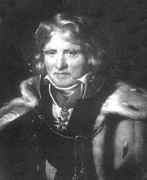◀ ▲ ▶History / 18th-century / Person: De Prony, Gaspard Clair François Marie Riche
Person: De Prony, Gaspard Clair François Marie Riche

Gaspard de Prony was a French mathematician who produced mathematical tables and texts on mathematical physics.
Mathematical Profile (Excerpt):
- De Prony was educated at the Benedictine College at Toissei in Doubs.
- From there he entered the École des Ponts et Chaussés in 1776 where he studied engineering.
- In 1780 he became an engineer with the École des Ponts et Chaussés and after three years in a number of different regions of France he returned to the École des Ponts et Chaussés in Paris 1783.
- This was the same year he published his first major work in the Académie des Sciences on the forces on arches.
- Monge was impressed with this paper and realised that de Prony was someone of great potential.
- In 1785 de Prony visited England on a project to obtain an accurate measurement of the relative positions of the Greenwich Observatory and the Paris Observatory.
- Two years later he was promoted to inspector at the École des Ponts et Chaussés.
- Further promotion in 1790 was followed the next year by his being appointed Engineer-in-Chief of the École des Ponts et Chaussés.
- Also around 1791 de Prony was working on geometry with Pierre Girard.
- Then in 1792, de Prony began a major task of producing logarithmic and trigonometric tables, the Cadastre.
- With the assistance of Legendre, Carnot and other mathematicians, and between 70 to 80 assistants, the work was undertaken over a period of years, being completed in 1801.
- In 1794 the École Centrale des Travaux Publics was founded by and was directed by Carnot and Monge.
- It was renamed the École Polytechnique in 1795 and de Prony was certainly one of the main lectures by this time.
- De Prony's lectures given at the École Polytechnique were published, including his lectures on hydraulics.
- In 1798 de Prony refused Napoleon's request that he join his army of invasion to Egypt.
- Fourier, Monge and Malus had agreed to be part of the expeditionary force and Napoleon was angry that de Prony would not come.
- In 1798 de Prony achieved his ambition of being appointed director of the École des Ponts et Chaussés.
- His desire for this post was almost certainly a main reason for his refusing to join Napoleon.
- He became a member of the Bureau de Longitude and, in 1810 and 1811, he produced two further major texts from his lectures at the École Polytechnique, namely "Leçons de Mécanique Analytique" Ⓣ(Lessons on analytical mechanics) and Sommaire des Leçons du Cours de Mécanique Ⓣ(Summary of lessons in a course on mechanics).
- After Napoleon was defeated the reorganisation in France included a reorganisation of the École Polytechnique which was closed during 1816.
- De Prony lost his position as professor there and was not part of the reorganisation committee.
- However, as soon as the school reopened, de Prony was asked to be an examiner so he continued his connection yet only had to work one month per year.
- One of de Prony's most important scientific inventions was the 'de Prony brake' which he invented in 1821 to measure the performance of machines and engines.
- It was based on ideas of Hachette and was a considerable improvement on a method which Pierre Girard had used two years earlier.
- The last part of de Prony's career was more involved with education rather than administration.
- One battle he fought, without success, was against Cauchy's move towards pure mathematics and away from the more applied mathematics which de Prony firmly believed in.
- He was disillusioned by the failure of his attempts to reform mathematics teaching at the École Polytechnique, where he had made energetic and determined efforts to combat the emphasis on theory of A-L Cauchy ...
- Prony seems to have lost heart for the continuing struggle and to have been less conscientious with regard to his duties as examiner.
Born 22 July 1755, Chamelet, Beaujolais, France. Died 29 July 1839, Paris, France.
View full biography at MacTutor
Thank you to the contributors under CC BY-SA 4.0! 

- Github:
-

- non-Github:
- @J-J-O'Connor
- @E-F-Robertson
References
Adapted from other CC BY-SA 4.0 Sources:
- O’Connor, John J; Robertson, Edmund F: MacTutor History of Mathematics Archive
